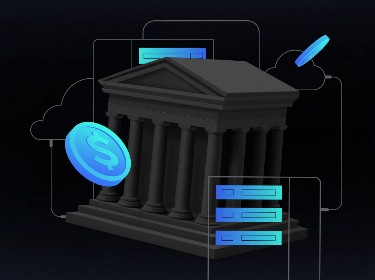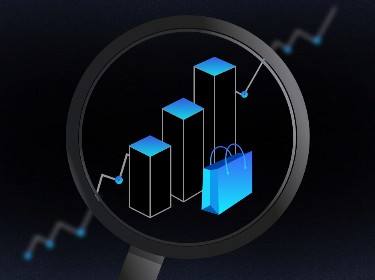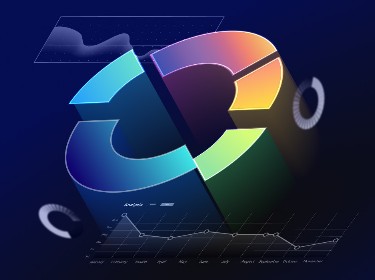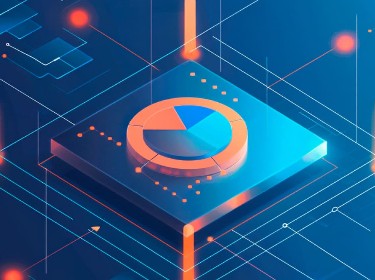Predicting future trends is now possible for us Muggles too. Armed with the power of advanced data analytics tools, we can unveil hidden patterns and carve out a path for strategic decision-making.
Predictive analytics helps businesses analyze historical data, identify patterns, and predict outcomes. This field harnesses a variety of technologies, including data mining, machine learning, artificial intelligence, statistical analysis, business intelligence, and data visualization to forecast consumer trends, and market shifts, and enable faster and more informed decision-making. By integrating predictive analytics into business intelligence services, companies can uncover valuable insights from their data, streamline operations, and gain a competitive edge.
Basically, predictive analytics is transforming the art of business strategy into a science, where every decision is backed by data-driven foresight. It’s all about working smarter, not harder.
Curious about real-world examples of predictive analytics? Let’s delve into how this approach is used in different industries and uncover its benefits for your business.
Our big data engineering services transform your data into actionable insights and fuel business growth with advanced analytics
7 predictive analytics examples in various industries
![]()
Let’s explore the 7 predictive analytics examples from industries such as sports, marketing, finance, retail, healthcare, manufacturing, and supply chain and see how this tool is used to transform operations, enhance customer experience, and drive innovation.
1. Sports
Examples of predictive analytics in the sports field include:
- Performance optimization: By analyzing data from past performances, coaches and athletes can identify areas for improvement and optimize training strategies. This can include adjustments in technique, fitness routines, and even nutritional plans.
- Injury prevention: Predictive models can analyze data on player movements, game intensity, and historical injury records to predict and prevent potential injuries. This helps in managing players’ fitness and reducing downtime.
- Game strategy development: Coaches and analysts can use predictive analytics to develop game strategies by studying opponents’ past games, identifying patterns in their play, and predicting their future moves. This is highly relevant for game development services for the entertainment and eSports industry, where understanding player behavior and predicting trends can lead to more engaging and competitive games.
- Team composition: Analytics provide insights into a player’s value and potential regression, aiding in contract negotiations and building balanced, effective teams.
- Marketing activities: Sports organizations can use predictive analytics to enhance fan engagement by analyzing fan behavior and preferences. This can inform marketing strategies, merchandise development, and even the scheduling of games. IT consulting services for the entertainment and eSports industry can leverage this data to optimize marketing campaigns, sponsorship deals, and overall fan experience.
- Revenue optimization: By analyzing ticket sales, viewership data, and fan engagement, sports franchises can optimize pricing strategies for tickets, merchandise, and concessions, maximizing revenue.
Real-life example of predictive analytics in sports
One of the best predictive analytics examples is the way the US National Football League (NFL) utilizes this approach. They use predictive analytics to transform various aspects of the game, from fan engagement to team performance.
According to Paul Ballew, the NFL’s chief data and analytics officer, the primary focus is on enhancing the experience for both the players and the fans. In the context of team performance, each of the 32 NFL clubs incorporates predictive analytics into their football operations. This strategic use of data is evident in football strategy decisions. For instance, teams are now more frequently choosing to go for it on fourth down, a decision driven by probability analysis.
Additionally, Ballew highlights the role of analytics in areas like officiating, rule changes, and player health and safety. Beyond the field, the NFL uses data to understand fan behavior and preferences, personalizing fan engagement and the customer experience. The increasing use of wearable technology and connected devices opens up new possibilities for data collection and analysis. IoT services for the entertainment and eSports industry can help gather real-time data on player performance, audience engagement, and venue conditions, providing valuable insights for optimizing strategies and enhancing the overall experience.
Check out this app for personalized workout plans and expert guidance, and turn to us to create your own platform that caters to your audience
2. Marketing
Employing predictive analytics in marketing decision-making leads to more personalized and effective strategies.
Below are detailed examples of predictive analytics being applied in the field:
- Hyper-personalized content creation: This involves customizing marketing campaigns based on users’ past interactions and developing personalized video content that adapts to user engagement in real-time.
- Customer journey optimization: By analyzing customer pathways and interactions, predictive analytics identifies critical touchpoints and forecasts the most effective routes for customer engagement. This streamlines the journey and enhances the overall customer experience.
- Predictive lead scoring: This uses advanced algorithms to score leads based on their likelihood to convert. The method analyzes past interactions, demographic data, and behavioral patterns to prioritize leads with a higher probability of resulting in sales.
- Churn prediction and prevention: This identifies patterns and indicators that a customer is likely to discontinue using a service or product. Predictive analytics enables marketers to proactively engage with these customers through targeted retention strategies, specifically addressing the challenges of customer churn.
- Sentiment analysis for brand health monitoring: This employs natural language processing to assess public sentiment about a brand or product on social media and other digital platforms, aiding in brand reputation management.
- Forecasting market trends: Data analytics predicts future market trends and consumer behaviors, allowing companies to stay ahead in product development, marketing strategies, and inventory management.
Real-life example of predictive analytics in marketing
Nike is harnessing the power of predictive analytics in its marketing strategies by integrating data from various sources to anticipate customer needs and optimize its product offerings.
The acquisition of predictive analytics companies Zodiac and Celect in 2018 and 2019 has enabled Nike to analyze data from apps and IoT devices like Fitbits, enhancing their understanding of customer habits and purchasing behaviors. This data has been used to personalize content and product recommendations in Nike’s app and improve inventory management.
Additionally, Nike’s leadership team utilizes a fully integrated data analytics system, complete with personalized dashboards and visualization tools, to make data-driven decisions. This approach helps in creating better products and services and strengthening Nike’s direct-to-consumer (DTC) initiatives.
3. Finance
![]()
Data analytics encompasses a range of techniques and tools used to forecast future FinTech trends and outcomes. However, this is just one of many predictive analytics examples in finance. Here are more:
- Credit scoring: Predictive analytics is used to assess the creditworthiness of borrowers. It analyzes past financial behavior and other relevant data, enabling financial institutions to predict the likelihood of a borrower fully repaying a loan.
- Fraud detection: Financial software development providers engineer predictive analytics tools for financial institutions that help identify unusual patterns that may indicate fraudulent activity. This involves analyzing transaction data to spot anomalies that deviate from a customer’s typical behavior.
- Risk management: In risk management, predictive analytics helps in forecasting potential risks and their impact. This includes market risk, credit risk, and operational risk, enabling institutions to mitigate potential losses.
- Algorithmic trading: Predictive analytics is employed in algorithmic trading to forecast market movements and make automated trading decisions. This involves analyzing historical and real-time data to predict stock price movements.
- Portfolio management: Predictive analytics assists in optimizing investment portfolios by forecasting the performance of various assets. This helps investors make informed decisions about where to allocate their funds.
Leverage our data analytics services to help your business uncover valuable insights, identify trends, and make accurate predictions
Real-life example of predictive analytics in finance
HSBC, a British universal bank and financial services group, is leveraging data analytics in several innovative and impactful ways. One of the key areas is in the detection and prevention of financial crime.
In their 2022 Annual Risk Review, they said,
“We continue to develop our fraud controls and invest in capabilities to fight financial crime through the application of advanced analytics and artificial intelligence.”
HSBC utilizes its own AI-based tool for data analytics, markedly improving their detection of suspicious activities. This tool, which was rolled out in November 2021, has enhanced the process of identifying such activities. It has achieved this by doubling the detection speed compared to former methods and cutting down the volume of cases by 60%.
4. Retail
Predictive analytics plays a crucial role in the retail software development by utilizing data to forecast trends, optimize operations, and enhance customer experiences.
Let’s dive a little deeper into other predictive analytics examples in this sector:
- Customer behavior analysis and prediction: By analyzing purchasing data, retailers can predict future buying patterns, enabling personalized marketing and optimal stock management. Additionally, this technology can identify customers who are likely to discontinue shopping, allowing for the implementation of targeted retention strategies.
- Inventory and supply chain management: Predictive analytics aids in forecasting product demand to maintain optimal stock levels and minimize overstocking or stockouts. It also predicts supply chain disruptions, enabling proactive measures for smooth retail operations.
- Price optimization: Retailers use predictive models to determine the best pricing strategies for products, taking into account factors like demand, competition, and market trends.
- Product recommendation systems: Retailers use customer data to predict what products a customer is likely to be interested in, enhancing cross-selling and upselling opportunities.
- Customer sentiment analysis: This involves using predictive analytics to assess customer sentiment from social media and other sources, aiding in brand management and the development of marketing strategies.
Real-life example of predictive analytics in retail
PepsiCo utilizes a sophisticated predictive analytics tool called pepviz, a unique blend of data, analytics, and industry expertise, specifically designed to empower PepsiCo’s frontline sales teams.
What exactly does pepviz do? It tracks current consumer trends and forecasts future demands. This predictive capability enables PepsiCo to understand which products should be on store shelves in the upcoming period.
The use of pepviz has also fostered a more collaborative and creative environment within PepsiCo and with its retail partners. By combining the expertise of PepsiCo’s business professionals with data science, the company has been able to innovate and create new strategies and solutions that were previously unexplored. This collaborative approach has resulted in more inventive and effective retail strategies, benefiting both PepsiCo and its retail partners.
5. Healthcare
Predictive analytics examples in healthcare demonstrate how data-driven insights can significantly improve patient outcomes and operational efficiency. Here’s a list:
- Patient risk identification: Predictive analytics can analyze patient data to identify individuals at high risk for certain conditions, enabling early intervention and personalized care plans.
- Readmission rate reduction: By examining patient records and historical data, healthcare providers can predict which patients are more likely to be readmitted, allowing for targeted post-discharge care to reduce readmissions.
- Drug development and personalization: Predictive models can accelerate drug development by identifying potential drug targets and predicting drug responses, leading to more personalized and effective treatments.
- Resource allocation optimization: Hospitals and clinics can use predictive analytics to forecast patient inflow, helping in the optimal allocation of staff, beds, and medical resources.
- Chronic disease management: Predictive analytics enables healthcare providers to monitor and manage chronic diseases more effectively by predicting exacerbations and tailoring treatment plans.
Real-life example of predictive analytics in healthcare
American healthcare providers Geisinger and UNC Health leverage predictive AI to enhance patient care and operational efficiency.
Geisinger has developed a sophisticated risk stratification model that incorporates over 800 factors to identify patients with chronic diseases who are at high risk of emergency department admissions.
The model aids in timely interventions by case managers, significantly reducing avoidable emergency visits and hospital admissions. Geisinger’s chief innovation and digital transformation officer, Karen Murphy, emphasizes the model’s role in focusing care teams on the right patients at the right time, leading to a 10% reduction in unnecessary emergency department visits and hospital admissions among patients with chronic conditions.
Similarly, UNC Health utilizes predictive AI to combat sepsis, a condition that can rapidly become fatal. Rachini Moosavi, UNC Health’s chief analytics officer, highlighted the challenges of existing models, such as high false positive rates leading to alert fatigue among clinicians. To overcome this, UNC Health developed its own custom model for early sepsis detection, tailored to their clinicians’ workflows.
We have extensive experience in developing applications for the healthcare industry. Explore our offerings to see what we can do for you
6. Manufacturing
![]()
Let’s take a look at the examples that illustrate how predictive analytics is transforming the manufacturing industry:
- Predictive maintenance: This involves analyzing data from machinery to predict potential equipment failures. Consequently, you can schedule maintenance before any breakdown occurs, thereby saving costs and reducing downtime.
- Quality control: Predictive manufacturing analytics can be used to anticipate defects and quality issues in products by analyzing production data. This helps in taking proactive measures to ensure product quality and reduce waste.
- Supply chain optimization: By analyzing data from various points in the supply chain, manufacturers can predict and respond to supply and demand changes and optimize inventory levels.
- Energy consumption analysis: Manufacturers use predictive analytics to monitor and predict energy usage patterns. They can then optimize energy consumption, leading to cost savings and lowered environmental impact.
- Warranty analytics: Predictive analytics can help understand and predict warranty claims, enabling manufacturers to address issues proactively and more effectively manage warranty costs.
Real-life example of predictive analytics in manufacturing
Metso, a Helsinki-based company specializing in sustainable minerals processing technologies, implemented AI-driven predictive maintenance and asset optimization through its Metso Metrics for Mining solution.
This approach is designed to address the traditionally low utilization of fixed assets, poor energy efficiency, and high levels of downtime in mining. By leveraging IIoT-driven connectivity, Metso Metrics collects data from equipment sensors and utilizes advanced AI algorithms to detect failure patterns and predict potential problems. This system has significantly reduced unplanned downtime and improved maintenance predictability and accuracy, leading to enhanced operational and energy efficiency.
7. Supply chain
Here are some predictive analytics examples of how this technology can be applied in supply chain and logistics software development services:
- Demand forecasting: Predictive analytics in supply chain helps in forecasting future customer demand, which allows companies to optimize inventory levels, reducing the risk of stockouts or excess inventory.
- Supplier performance analysis: By evaluating the historical performance data of suppliers, predictive analytics can identify potential risks and issues in the supply chain. This includes assessing the likelihood of delays, quality issues, or financial instability of suppliers, enabling proactive measures to mitigate these risks.
- Transportation and logistics optimization: Predictive analytics can optimize routing and delivery schedules by analyzing traffic patterns, weather conditions, and delivery performance data.
- Risk management: By analyzing various risk factors such as geopolitical events, natural disasters, or market fluctuations, predictive analytics can help identify potential disruptions in the supply chain. This enables companies to develop contingency plans and strategies to minimize impact.
- Customer service improvement: By predicting potential issues in the supply chain that could affect customer service, such as delays or quality problems, companies can take preemptive actions to address these issues, thereby enhancing customer satisfaction.
Real-life example of predictive analytics in supply chain
Amazon uses predictive analytics to master its supply chain management. By scrutinizing historical sales, customer behaviors, and external influences like seasonality, they adeptly forecast product demand. This insight helps maintain optimal inventory, balancing the availability of in-demand items with minimal surplus.
Additionally, Amazon’s analysis of shipping logistics and customer geography informs smart decisions on inventory distribution and transportation. The outcome is quicker deliveries, heightened customer satisfaction, and lower operational expenses.
Meet Scargos, a cutting-edge logistics solution by PixelPlex. It streamlines connections between shippers, carriers, and drivers for efficient cargo transportation
Final thoughts
From healthcare’s personalized patient care plans to retail’s inventory management, and from finance’s risk assessment to manufacturing’s maintenance scheduling, the examples of predictive analytics are as diverse as they are impactful.
However, the true potential of this technology can only be fully unlocked when paired with the expertise and innovative solutions provided by companies like PixelPlex.
PixelPlex offers a suite of predictive analytics services and solutions that are not only cutting-edge but also tailored to the unique needs of each industry. Plus, our experienced ML consultants alongside AI developers will be eager to assist you along the way.
Reach out to our experts, and let us partner with you to foster innovation and enhance efficiency in your operations and beyond.




